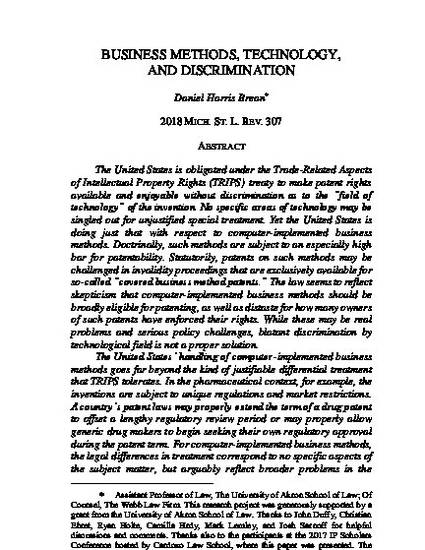
Article
Business Methods, Technology, and Discrimination
Michigan State Law Review
(2018)
Abstract
The United States is obligated under the Trade-Related Aspects of Intellectual Property Rights (TRIPS) treaty to make patent rights available and enjoyable without discrimination as to the “field of technology” of the invention. No specific areas of technology may be singled out for unjustified special treatment. Yet the United States is doing just that with respect to computer-implemented business methods. Doctrinally, such methods are subject to an especially high bar for patentability. Statutorily, patents on such methods may be challenged in invalidity proceedings that are exclusively available for so-called “covered business method patents.” The law seems to reflect a skepticism that computer-implemented business methods should be broadly eligible for patenting, as well as a distaste for how many owners of such patents have enforced their rights. While these may be real problems and serious policy challenges, blatant discrimination by technological field is not a proper solution.
The United States’ handling of computer-implemented business methods goes far beyond the kind of justifiable differential treatment that TRIPS tolerates. In the pharmaceutical context, for example, the inventions are subject to unique regulations and market restrictions. A country’s patent laws may properly extend the term of a drug patent to offset a lengthy regulatory review period, or may properly allow generic drug makers to begin seeking their own regulatory approval during the patent term. For computer-implemented business methods, the legal differences in treatment correspond to no specific aspects of the subject matter, but arguably reflect broader problems in the United States patent system concerning patent examination quality and litigation abuse.
None of this discrimination is in violation of the treaty, however, unless computer-implemented business methods are a “field of technology” under TRIPS. Congress and the USPTO have ostensibly assumed not, focusing on the fact that such methods use existing computer technology but do not create new computer technology per se. But that goes to how inventive the method is, not whether it is technological. The text of the treaty, the pre- and post-ratification conduct of the member countries, and the historical and normative context all suggest that computer-implemented business methods are indeed technological. While the computerization of such processes is not usually inventive enough to ultimately be patented, employing computers for practical business purposes nonetheless brings such methods within the scope of the treaty and deserving of nondiscriminatory treatment. As the United States considers more changes to the availability and enjoyment of patent rights, it should discontinue this discrimination.
Keywords
- business methods,
- patent,
- TRIPS,
- 101,
- alice,
- discrimination,
- CBM
Disciplines
Publication Date
2018
Citation Information
Daniel Harris Brean. "Business Methods, Technology, and Discrimination" Michigan State Law Review Vol. 2018 Iss. 2 (2018) Available at: http://works.bepress.com/daniel_brean/13/
